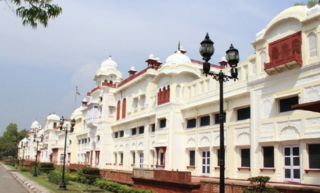
Patiala is a city in southeastern Punjab, northwestern India. It is the fourth largest city in the state and is the administrative capital of Patiala district. Patiala is located around the Qila Mubarak constructed by the Sidhu Jat Sikh chieftain Ala Singh, who founded the royal dynasty of Patiala State in 1763, and after whom the city is named.
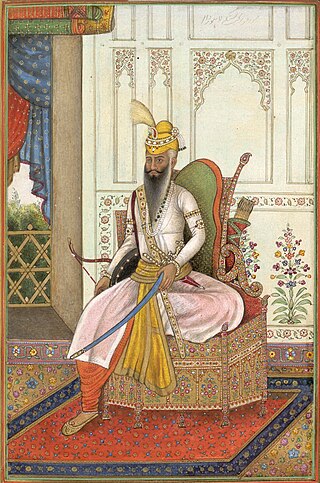
Ranjit Singh, popularly known as Sher-e-Punjab or "Lion of Punjab", was the first Maharaja of the Sikh Empire, which ruled the northwest Indian subcontinent in the early half of the 19th century. He survived smallpox in infancy but lost sight in his left eye. He fought his first battle alongside his father at age 10. After his father died, he fought several wars to expel the Afghans in his teenage years and was proclaimed as the "Maharaja of Punjab" at age 21. His empire grew in the Punjab region under his leadership through 1839.

The Lahore Fort is a citadel in the city of Lahore in Punjab, Pakistan. The fortress is located at the northern end of Walled city of Lahore and spreads over an area greater than 20 hectares. It contains 21 notable monuments, some of which date to the era of Emperor Akbar. The Lahore Fort is notable for having been almost entirely rebuilt in the 17th century, when the Mughal Empire was at the height of its splendor and opulence.

Maharaja Sir Duleep Singh, GCSI, or Sir Dalip Singh, and later in life nicknamed the "Black Prince of Perthshire", was the last Maharaja of the Sikh Empire. He was Maharaja Ranjit Singh's youngest son, the only child of Maharani Jind Kaur.

Captain Amarinder Singh, is an Indian politician, military historian, former royal and Indian Army veteran who served as the 15th Chief Minister of Punjab. A former Member of the Legislative Assembly, Punjab and Member of Parliament, Lok Sabha, he was also the president of Punjab Pradesh Congress Committee. He has also previously served as the Chief Minister of Punjab from 2002 to 2007 and 2017 to 2021. His father was the last Maharaja of the princely state of Patiala. He has also served in the Indian Army from 1963 to 1966. In 1980, he won a seat in the Lok Sabha for the first time. As of November 2022, Singh also serves as the chairman of the Punjab Urdu Academy. Captain Singh resigned as the Chief Minister of Punjab on 18 September 2021. On 19 September 2022 he merged his party PLC with BJP and joined BJP on the same day.

Maha Singh, also spelt as Mahan or Mahn Singh, was the second chief of the Sukerchakia Misl. He was the eldest son of Sardar Charat Singh and Sardarni Desan Kaur Warraich. He was the father of Sher-e-Punjab Maharaja Ranjit Singh.

Majha is a region located in the central parts of the historical Punjab region split between India and Pakistan. It extends north from the right banks of the river Beas, and reaches as far north as the river Jhelum. People of the Majha region are given the demonym "Mājhī" or "Majhail". Most inhabitants of the region speak the Majhi dialect, which is the basis of the standard register of the Punjabi language. The most populous city in the area is Lahore on the Pakistani side, and Amritsar on the Indian side of the border.

The Maharaja of Patiala was a maharaja in India and the ruler of the princely state of Patiala, a state in British India. The Maharajas of Patiala were Sidhu Jat. The first Maharaja of Patiala was Baba Ala Singh (1695–1765).

Maharaja Sir Bhupinder Singh, was an Indian royal and cricket player. He was the ruling Maharaja of the princely state of Patiala in British India from 1900 to 1938. He was born in a Sidhu royal Jat Sikh family.

Preneet Kaur is an Indian politician who served in the Government of India as a Minister of State in the Ministry of External Affairs from 2009 to 2014. She is married to Amarinder Singh, who was the 15th Chief Minister of Punjab. She joined the Congress party, to which her husband also belonged once, and contested parliamentary elections repeatedly from the Patiala constituency. In February 2023, she was suspended from party for supporting BJP leader and her husband Amarinder Singh. She won the elections of 1999, 2004 and 2009, but lost her seat in the elections of 2014 and made a comeback by winning again in 2019.
The Sikhs are adherents to Sikhism, the fifth largest organized religion in the world, with around 25 million adherents. Sikh History is around 500 years and in that time the Sikhs have developed unique expressions of art and culture which are influenced by their faith and synthesize traditions from many other cultures depending on the locality of the adherents of the religion. Sikhism is the only religion that originated in the Punjab region with all other religions coming from outside Punjab. All the Sikh gurus, many saints, and many of the martyrs in Sikh history were from Punjab and from the Punjabi people. Punjabi culture and Sikhism are mistakenly considered inseparably intertwined. "Sikh" properly refers to adherents of Sikhism as a religion, strictly not an ethnic group. However, because Sikhism has seldom sought converts, most Sikhs share strong ethno-religious ties, therefore it is a common stereotype that all Sikhs share the same ethnicity. Many countries, such as the U.K., therefore misconcievingly recognize Sikh as a designated ethnicity on their censuses. The American non-profit organization United Sikhs has fought to have Sikhs included on the U.S. census as well, arguing that Sikhs "self-identify as an 'ethnic minority'" and believe "that they are more than just a religion".

Yadavindra Singh was the 9th and last ruling Maharaja of Patiala from 1938 to 1971. He was also a diplomat, sports administrator and former cricketer who played in one Test in 1934.
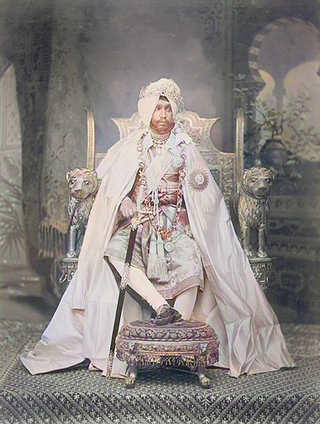
Sir Rajinder Singh was the Maharaja of the princely state of Patiala from 1876 to 1900. In 1897, he was awarded the Grand Cross of the Star of India for his bravery, by the colonial government. Described as "the first reigning Prince to blend the elements of the English gentleman and Indian potentate."

The Phulkian Dynasty of Maharajas or sardars were Jat-Sikh rulers and aristocrats in the Punjab region of India. They governed the states of Faridkot, Jind, Nabha, Malaudh and Patiala, allying themselves with the British Raj as per the Cis-Sutlej treaty. The Phulkain sardars are the descendants of Rawal Jaisal of Jaisalmer, who migrated to present day Malwa region of Punjab. The Phulkian dynasty claimed descent from Rawal Jaisal, the Bhati Rajput founder of Jaisalmer.

Mehtab Kaur, was the second wife of the ninth and the last Maharaja of Patiala Yadavindra Singh (1913–1974). She was the mother of Amarinder Singh, the former Chief Minister of Punjab. Had it not been for the erstwhile Indian princely families being stripped of their titles in 1971, upon the death of her husband she would have been considered Rajmata, and in popular usage is commonly referred to as such.

Patiala State was a self-governing princely state of the British Empire in India, and one of the Phulkian States, that acceded to the Union of India upon Indian independence and partition. Patiala Kingdom/State was founded by Sidhu Jat Sikhs.
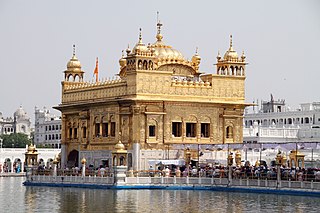
The state of Punjab is renowned for its cuisine, culture and history. Punjab has a vast public transportation and communication network.
Rani Raj Kaur was the wife of Maha Singh, the leader of the Sukerchakia Misl and the mother of Maharaja Ranjit Singh, the founder of the Sikh Empire. She was affectionately known as Mai Malwain after her marriage. She is also referred to as Sardarni Raj Kaur and was daughter of Raja Gajpat Singh Sidhu of Jind.

Punjab Sports University, officially Maharaja Bhupinder Singh Punjab Sports University (MBSPSU), is a residential and affiliating sports state university in Patiala, Punjab, India.
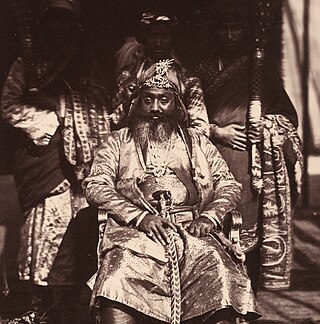
Narinder Singh , also spelt as Narendra Singh, was Maharaja of the princely state of Patiala from 1845 to 1862. He was one of the first local rulers to receive the Order of the Star of India and was a Member of the Indian Legislative Council during Lord Canning's Viceroyalty.





















